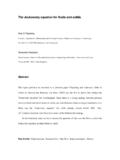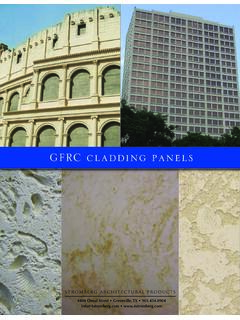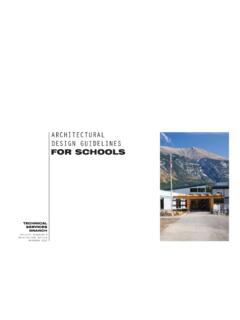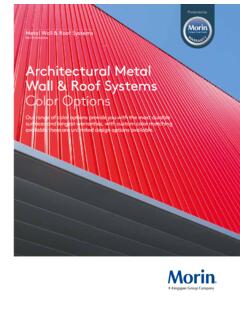Transcription of Software architecture: Architectural Styles
1 2IW80 Software specification and architecture Software architecture: Architectural Styles Alexander Serebrenik Before we / SET / W&I PAGE 1 18-3-2014 True or false? Domain-Specific Software Architecture is a part of a Reference Architecture. Before we / SET / W&I PAGE 2 18-3-2014 True or false? Domain-Specific Software Architecture is a part of a Reference Architecture: FALSE Domain-Specific Software Architecture is broader applicable than a product line. Before we / SET / W&I PAGE 3 18-3-2014 True or false? Domain-Specific Software Architecture is a part of a Reference Architecture: FALSE Domain-Specific Software Architecture is broader applicable than a product line: TRUE Model-View-Controller is an examples of a Domain-Specific Software Architecture Before we / SET / W&I PAGE 4 18-3-2014 True or false? Domain-Specific Software Architecture is a part of a Reference Architecture: FALSE Domain-Specific Software Architecture is broader applicable than a product line: TRUE Model-View-Controller is an examples of a Domain-Specific Software Architecture FALSE This week sources Slides by Johan Lukkien Rudolf Mak Recall: Architectural patterns vs.
2 Architectural Styles vs. Design patterns Architectural patterns define the implementation strategies of those components and connectors ( how? ) More domain specific Architectural Styles define the components and connectors ( what? ) Less domain specific Good architecture makes use of design patterns (on a more fine-granular level) We ll see examples later on Usually domain independent / SET / W&I PAGE 6 18-3-2014 2 IPC0 Architectural Styles An Architectural style is a named collection of Architectural design decisions that are applicable in a given development context constrain Architectural design decisions that are specific to a particular system within that context elicit beneficial qualities in each resulting system Reflect less domain specificity than Architectural patterns Useful in determining everything from subroutine structure to top-level application structure Many Styles exist and we will discuss them in detail in the next lecture Software Architecture: Foundations, Theory, and Practice; Richard N.
3 Taylor, Nenad Medvidovic, and Eric M. Dashofy; 2008 John Wiley & Sons, Inc. Reprinted with permission. Benefits of Using Styles Reuse Design: Well-understood solutions applied to new problems Code: Shared implementations of invariant aspects of a style Understandability of system organization A phrase such as client-server conveys a lot of information Interoperability Supported by style standardization Style-specificity Analyses: enabled by the constrained design space Visualizations: depictions matching engineers mental models Software Architecture: Foundations, Theory, and Practice; Richard N. Taylor, Nenad Medvidovic, and Eric M. Dashofy; 2008 John Wiley & Sons, Inc. Reprinted with permission. Basic Properties of Styles A vocabulary of design elements Component and connector types; data elements , pipes, filters, objects, servers Software Architecture: Foundations, Theory, and Practice; Richard N.
4 Taylor, Nenad Medvidovic, and Eric M. Dashofy; 2008 John Wiley & Sons, Inc. Reprinted with permission. Recap: Connectors Architectural Styles define the components and connectors A Software connector is an Architectural building block tasked with effecting and regulating interactions among components (Taylor, Medvidovic, Dashofy) Procedure call connectors Shared memory connectors Message passing connectors Streaming connectors Distribution connectors Wrapper/adaptor connectors .. / SET / W&I PAGE 10 18-3-2014 Basic Properties of Styles A vocabulary of design elements Component and connector types; data elements , pipes, filters, objects, servers A set of configuration rules Topological constraints that determine allowed compositions of elements , a component may be connected to at most two other components A semantic interpretation Compositions of design elements have well-defined meanings Possible analyses of systems built in a style Software Architecture: Foundations, Theory, and Practice; Richard N.
5 Taylor, Nenad Medvidovic, and Eric M. Dashofy; 2008 John Wiley & Sons, Inc. Reprinted with permission. Some Common Styles Traditional, language-influenced Styles Main program and subroutines Object-oriented Layered Virtual machines Client-server Data-flow Styles Batch sequential Pipe and filter Shared memory Blackboard Rule based Interpreter Interpreter Mobile code Implicit invocation Event-based Publish-subscribe Peer-to-peer Derived Styles C2 CORBA Software Architecture: Foundations, Theory, and Practice; Richard N. Taylor, Nenad Medvidovic, and Eric M. Dashofy; 2008 John Wiley & Sons, Inc. Reprinted with permission. Architecture Style Analysis Summary Design elements (components, connectors, data) Topology Examples of use Advantages/disadvantages Relation to programming languages/environments / SET / W&I PAGE 13 18-3-2014 Main program and subroutines You should be familiar with this style from a basic programming course / SET / W&I PAGE 14 18-3-2014 Main program: displays greetings and instructions enters a loop in which it calls the three subroutines in turn.
6 Main program and subroutines: Style Analysis Summary: Decomposition based upon separation of functional processing steps Design elements Components: main program and subroutines Connectors: function/procedure calls Data: Values passed in/out subroutines Topology Static organization is hierarchical Full structure: a directed graph Software Architecture: Foundations, Theory, and Practice; Richard N. Taylor, Nenad Medvidovic, and Eric M. Dashofy; 2008 John Wiley & Sons, Inc. Reprinted with permission. Main program and subroutines: Style Analysis What are common examples of its use? Small programs, pedagogical uses What are the advantages of using the style? Modularity: subroutines can be replaced as long as interface semantics are unaffected What are the disadvantages of using the style? Usually fails to scale Inadequate attention to data structures Effort to accommodate new requirements: unpredictable Relation to programming languages/environments Traditional programming languages: BASIC, Pascal, Software Architecture: Foundations, Theory, and Practice; Richard N.
7 Taylor, Nenad Medvidovic, and Eric M. Dashofy; 2008 John Wiley & Sons, Inc. Reprinted with permission. Object-Oriented Lunar Lander You should be familiar with this style from an OO-programming course. Identify similarities and differences between the Styles . Object-Oriented Lunar Lander Similarities: connectors (procedure calls) + data (arguments) Object-Oriented Lunar Lander Similarities: connectors (procedure calls) + data (arguments) Differences: encapsulation (UI, SpaceCraft, Environment) Procedural: input & output are separated OO: input & output are together How would this look like as a class diagram? Software Architecture: Foundations, Theory, and Practice; Richard N. Taylor, Nenad Medvidovic, and Eric M. Dashofy; 2008 John Wiley & Sons, Inc. Reprinted with permission. EnvironmentSimulation moonGravity: double calculateStatus(burnRate: double, s: SpaceCraft): SpaceCraft SpaceCraft altitude: double fuel: double time: int velocity: double SpaceCraft(a:double, f:double, t:int, v: double) setAltitude(a: double) setFuel(f: double).
8 GetAltitude() getFuel() .. GUI burnRate: double getBurnRate(): double displayStatus(s:SpaceCraft) creates uses 1 1 1 * Object-Oriented Style: Style Analysis Summary: State strongly encapsulated. Internal representation is hidden from other objects Objects are responsible for their internal representation integrity Design elements Components: objects (data and associated operations) Connectors: method invocations Data: arguments passed to methods Topology Can vary arbitrarily: data and interfaces can be shared through inheritance Software Architecture: Foundations, Theory, and Practice; Richard N. Taylor, Nenad Medvidovic, and Eric M. Dashofy; 2008 John Wiley & Sons, Inc. Reprinted with permission. Object-Oriented Style: Style Analysis What are common examples of its use? pedagogy complex, dynamic data structures close correlation between physical world entities and entities in the program What are the advantages of using the style?
9 Integrity: data is manipulated only by appropriate methods Abstraction: internals are hidden Software Architecture: Foundations, Theory, and Practice; Richard N. Taylor, Nenad Medvidovic, and Eric M. Dashofy; 2008 John Wiley & Sons, Inc. Reprinted with permission. Object-Oriented Style: Style Analysis What are the disadvantages of using the style? Not efficient enough for high performance computing ( , scientific computing, data science) Distributed applications require extensive middleware to provide access to remote objects In absence of additional structural principles unrestricted OO can lead to highly complex applications Relation to programming languages/environments OO-languages: Java, C++.. Software Architecture: Foundations, Theory, and Practice; Richard N. Taylor, Nenad Medvidovic, and Eric M. Dashofy; 2008 John Wiley & Sons, Inc. Reprinted with permission. Layered Style Lunar Lander Basic idea: Each layer exposes an interface (API) to be used by the layer above it Each layer acts as a Server: service provider to layer above Client: service consumer of the layer below Taylor et al call this style virtual machines I do not like this name since these virtual machines are not related to simulation or program execution as in Java Virtual Machine , Python, etc.
10 / SET / W&I PAGE 24 18-3-2014 Layering Software Architecture: Foundations, Theory, and Practice; Richard N. Taylor, Nenad Medvidovic, and Eric M. Dashofy; 2008 John Wiley & Sons, Inc. Reprinted with permission. Strict Layering Nonstrict Layering Layered Style: Style Analysis Summary: An ordered sequence of layers, each layer offers services (interfaces) that can be used by programs (components) residing with the layer(s) above it Design elements Components: layers, each layer usually several programs Connectors: typically procedure calls Data: parameters passed between layers Topology Linear (strict layering), acyclic (non-strict layering) Software Architecture: Foundations, Theory, and Practice; Richard N. Taylor, Nenad Medvidovic, and Eric M. Dashofy; 2008 John Wiley & Sons, Inc. Reprinted with permission. Layered Style: Style Analysis What are common examples of its use? operating systems 2 INC0 Operating systems SfS:Y3Q1 network and protocol stacks 2IC60 Computer networks and security SfS, WbS:Y2Q4 Software Architecture: Foundations, Theory, and Practice; Richard N.




![cTRW]XbRWTd]XeTabXcTXcTX]SW^eT] Assignment 2 …](/cache/preview/d/5/c/4/6/f/6/0/thumb-d5c46f603d1ae108feb7b9bdb9fecab3.jpg)













